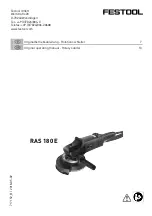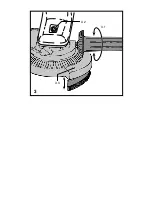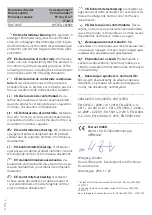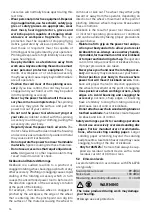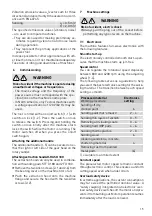
15
Vibration emission value a
h
(vector sum for three
directions) and uncertainty K measured in accord-
ance with EN 60745:
Sanding: a
h
= 3.5 m/s
2
K = 2.0 m/s
2
The specifi ed emissions values (vibration, noise)
– are used to compare machines.
– They are also used for making preliminary es-
timates regarding vibration and noise loads
during operation.
– They represent the primary applications of the
power tool.
Increase possible for other applications, with oth-
er insertion tools or if not maintained adequately.
Take note of idling and downtimes of machine!
6 Commissioning
WARNING
Risk of accident if the machine is operated using
unauthorised voltages or frequencies.
- The mains voltage and the frequency of the
power source must correspond with the spe-
cifi cations on the machine’s name plate.
- In North America, only Festool machines with
a voltage specifi cation of 120 V/60 Hz may be
used.
The tool is fi tted with an on/off switch [1-1] with
switch-on lock [1-2]. Press the switch-on lock
to release the switch. Pressing and holding the
switch-on lock briefl y after the machine starts
locks the switch while the motor is running. The
motor switches off when you press the on/off
switch again.
Attaching the additional handle
The additional handle (1-5) can be secured on ei-
ther the right or left side of the gear head on the
rotary sander.
Attaching extraction hood AH-RAS D 180
The extraction hood can only be used in combina-
tion with sanding pads STF D 180 and 2F D 180.
Remove the two Allen screws [2-1 and 2-6] from
the bearing cover on the machine fi rst of all.
Push the extraction hood onto the machine
fl ange and secure the hood with the two Allen
screws [2-2].
7 Machine
settings
WARNING
Risk of accident, electric shock
Always pull the plug out of the socket before
performing any type of work on the machine.
7.1 Electronics
The machine features full-wave electronics with
the following features:
Smooth start-up
The electronically controlled smooth start-up en-
sures that the machine starts up jolt-free.
Speed control
You can regulate the rotational speed steplessly
between 800 and 4200 rpm using the adjusting
wheel [1-4].
The following table serves as a guideline to help
you select the best electronics setting for the work-
ing material. The transition between each speed
setting is smooth.
Processed material
Working procedure
Electronics
setting
Sanding off dry,
cracked paint
6
Sanding paint that "smears"
2 - 4
Sanding thin layers of varnish
3 - 5
Removing anti-fouling coats
3 - 6
Sanding hard GRP parts
4 - 6
Sanding thermoplastics
2 - 3
Sanding wood
6
Cleaning sandstone, concrete,
shuttering material
4
Removing rust from painted
metal parts
(6)
( ) = suitable to a limited extent
Constant speed
The preselected motor speed remains constant
through electronic control. This ensures a uniform
cutting speed even when under strain.
Overload safety device
In extreme applications, the current consumption
may far exceed the permitted nominal value. A
"safety coupling" integrated in an electronic over-
load safety device switches off the motor and pre-
vents it from burning out. Motor operation resumes
immediately after the load is relieved.

